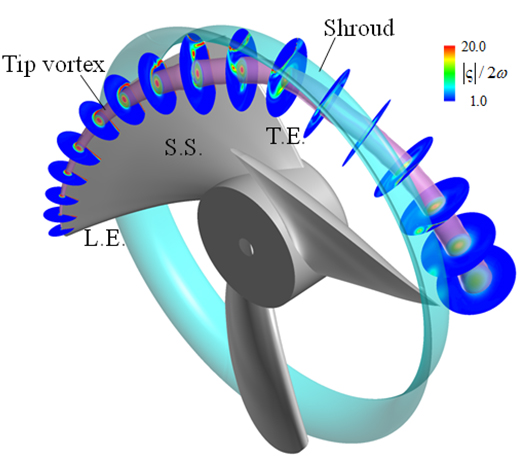Newsletter 2019.3 Index
Theme : "Mechanical Engineering Congress, 2019 Japan (MECJ-19)”
|
Fluid Machinery and Vortical Flow Phenomena
Masato FURUKAWA Kyushu University
|
Abstract
A flow diagnostic technique based on an EFD/CFD hybrid analysis approach and a smart data visualization has been developed to elucidate vortical flow phenomena in fluid machinery. The diagnostic technique has been applied to the breakdown of tip leakage vortex in compressor rotors, the rotating stall inception in a low-speed axial compressor rotor and a multi-stage transonic axial compressor, and the three-dimensional behavior of tip vortex in half-ducted propeller fans.
The breakdown of tip leakage vortex has been investigated on a low-speed axial compressor rotor with moderate blade loading. Effects of the breakdown on the rotor aerodynamics were elucidated by Navier-Stokes flow simulations and the smart data visualization techniques for identifying the breakdown. The leakage vortex breakdown occurs inside the rotor at a lower flow rate than the peak pressure rise operating condition. The breakdown is characterized by the existence of the stagnation point followed by a bubblelike recirculation region. The onset of breakdown causes significant changes in the nature of the tip leakage vortex: large expansion of the vortex and disappearance of the streamwise vorticity concentrated in the vortex as shown in Fig. 1.
The unsteady behavior and three-dimensional flow structure of rotating stall inception in an axial compressor rotor have been investigated by the EFD/CFD hybrid analyses. In order to capture the transient phenomena of the stall inception experimentally, an instantaneous casing pressure field measurement technique was developed. In addition, the details of the three-dimensional flow structure at the rotating stall inception were analyzed by a numerical approach using the detached-eddy simulation (DES). It was found that a leading-edge separation occurs near the tip at the onset of the rotating stall and grows to form the tornado-like vortex connecting the blade suction surface and the casing wall as shown in Fig. 2.
The flow mechanisms of rotating stall inception in a multistage axial flow compressor of an actual gas turbine have been investigated by large-scale DES with two billion grid points. The rotating stall started from a separation on the stator hub side rather than the commonly observed leading-edge separation near the rotor tip. The flow phenomenon first observed in the stalling process is the hub corner separation, which appears in a passage of the sixth stator when approaching the stall point. This hub corner separation grows with time, and eventually leads to a leading-edge separation on the hub side of the stator, as shown in Fig. 3. Once the leading-edge separation occurs, it rapidly develops into a rotating stall, causing another leading-edge separation of the neighboring blade.
The three-dimensional structure of the tip vortex in a half-ducted propeller fan has been investigated using DES results and LDV measurement data. The formation process of the tip vortex was elucidated by showing velocity and vorticity distributions in several cross-sections along the tip vortex center, as shown in Fig.4.
Key words
Fluid Machinery, Vortical Flow, Experimental fluid dynamics, Computational fluid dynamics.
Figures

Figure 1 Breakdown of tip leakage vortex in an axial compressor rotor at near-stall condition

Figure 2 Vortical flow structure at rotating stall inception of an axial compressor rotor

Figure 3 Vortical flow structures at rotating stall inception in a stator of a multistage axial compressor

Figure 4 Formation process of tip vortex in a half-ducted propeller fan


